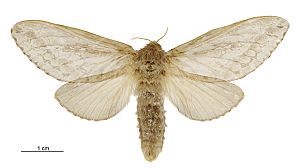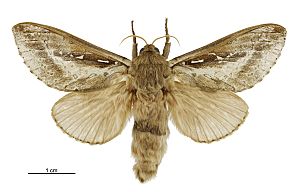Wiseana signata facts for kids
Quick facts for kids Wiseana signata |
|
|---|---|
 |
|
| Female specimen | |
 |
|
| Male specimen | |
| Scientific classification | |
| Kingdom: | |
| Phylum: | |
| Class: | |
| Order: | |
| Family: |
Hepialidae
|
| Genus: | |
| Species: |
W. signata
|
| Binomial name | |
| Wiseana signata (Walker, 1856)
|
|
| Synonyms | |
|
|
Wiseana signata is a special kind of moth that lives only in New Zealand. It belongs to a group of moths called Hepialidae. A scientist named Francis Walker first described this moth in 1856.
About the Wiseana signata Moth
This moth is unique because it is endemic to New Zealand. This means it is found naturally nowhere else in the world. It's a fascinating part of New Zealand's amazing wildlife.
What Does the Wiseana signata Look Like?
These moths have different sizes depending on if they are male or female.
- Male moths usually have a wingspan of about 44 to 64 millimeters.
- Female moths are a bit larger, with a wingspan of about 58 to 75 millimeters.
Their front wings have tiny white scales, which can make them look a bit frosty. The back wings are often a yellow-brown or pinkish-brown color. They also have a clear, dark line along the edge of their back wings.
Life Cycle and Food
Adult Wiseana signata moths can be seen flying around from October all the way through May. This is when they are fully grown.
The young moths, called larvae (or caterpillars), need food to grow. They mostly eat different kinds of grass. This makes them an important part of the grassland ecosystem in New Zealand.

